
How to Easily Move Your Bust & Waist Darts to Fit Your Figure
I am cooking up a new pattern and it has a fitted bodice with waist and bust darts. So I think this is a good time to talk about moving bust darts to fit your figure.
Even women of the same height could have busts sitting at different levels. This could be because of age, cup size or just body shape.
Do I Need an Adjustment?
First, let’s talk about where the bust dart is supposed to be, otherwise, we wouldn’t know whether the bust dart needs to be moved.
Some of the patterns have the apex marked on the front. Then that’s super easy: if the apex is not where your nipple is, then you need an adjustment. Usually the apex is marked with an “X” inside a circle. Sometimes they even have the finished bust measurements written next to it.
If you have a front pattern with a waist and a bust dart, then it’s not too hard to find the apex either. At the base of each dart, you find the middle point, from there, you draw a line to the bust point, and then continue the straight line a little more. You’d find at at some point, the line from the waist dart and the line from the bust dart will meet each other. That meeting point is the apex. Again, if this apex point is not where your nipple is, you’d need to move the bust dart, and potentially the waist dart too.
If you have a front pattern only with a bust dart, but not a waist dart, then it’s not as clear where the apex is. All you know is that the bust dart point is supposed to point to the apex. Similar to the previous method, you draw a line from the mid point at the base of the dart to the dart point. Continue with this straight line, and the apex is somewhere along this line. The actual apex could be 0.5″ to 2.5″ (1.25 to 6.3 cm) or even more from the dart point along this straight line. For our purpose, if the bust dart is pointing to your nipple, then I’d say the bust dart is OK. You could still move the dart point in or out to fit your bust better, but that would be some other adjustment that we are not discussing today. For now, if it’s pointing above or below your nipple, then you’d need to move the bust dart.
With all these said, to accurately determine where your apex is, you will need to make a muslin. You can’t very well judge the positions of your apex and the pattern’s apex by putting the paper on your chest. You could maybe do some tissue fitting if you are using tissue patterns, but if you are using PDF patterns, which is likely printed on regular printing paper, then you have to make a muslin.
How Do I Move the Dart?
Here are some easy steps to move your bust dart.
First put on the pattern’s apex if it’s not already there. See above for how to find the apex. If the pattern has no waist dart, use 1″ (2.5 cm) for blouses and dresses and 2″ (5 cm)for jackets and coats from the bust point along the straight line. These are estimates.
After making a muslin, you will find out where your apex should be. For me, I am using the blue dot for the purpose of this demo. The blue dot is 5/8″ (1.6 cm) to the right of and 1/2″ (1.25 cm) higher than the original apex.
Cut out the bust dart in a rectangle (4 straight sides and 4 right angles!!). The rectangle should include the entire bust dart and it should be perpendicular to the grain line. By looking at the photo below, you may think that the upper cut line is one of the dart leg, but it actually is not if you look closely. And if yours happens to be, it’s coincidental.
I need to move my dart 5/8″ (1.6 cm) to the right and 1/2″ (1.25 cm) up. So here it is in the adjusted position.
Tape everything down and put some paper underneath to fill the gap.
Now I need to true the dart. Fold the dart as if you are sewing it. It’s going to be awkward because paper is rigid. It’s not going to be flat. Do the best you can to put the two dart legs together. For a bust dart like this, 99% of the case the dart is supposed to be pressed down, so fold accordingly.
Cut the excess paper. The side cut line should be smooth.
When you open the dart back up, your dart is trued!
If your pattern only has a bust dart, then your task is done. But if it has a waist dart too, and it’s not pointing to the apex, then you need to move the waist dart accordingly. The process is the same. You draw a rectangle that contains the waist dart.
Cut it out and move to the left or the right. In my case, I need to move it 5/8″ (1.6 cm) to the right. I cut the rectangle out.
Move 5/8″ (1.6 cm) to the right. I could also place the whole dart 1/2″ (1.25) up because the new apex is 1/2″ up. In that case I would draw the dart legs down (while maintain the same width) after backing the gap with some paper. But I decide not to do that because I like the fit there. Remember the apex could be 0.5″ to 2″ or more from the dart point, so I have some leeway. The important thing is that the dart point is pointing toward my apex, the blue dot.
Tape everything down and put paper underneath to fill the gap.
Again, I need to true the dart. Fold it as if you are sewing it. The bulk of my waist dart is usually pressed toward the side, but others might be pressed differently, so check your pattern instructions. See how awkward the fold is? It’s going to be like that and we just have to deal with it as best as we can.
Cut the bottom excess paper to true the dart. Be sure that the line is smooth when you cut.
Open the paper back up and your dart is trued!
Ta da! Here’s the pattern with darts moved to accommodate your figure.
If this is a dress and there’s a skirt below the bodice with a corresponding waist dart, you will need to move that dart too. Otherwise your two darts will not match up.
If this is a dress with no waist seam but with a fish eye dart (a fish eye dart has two dart points, one pointing up and the other pointing down, kind of look like a side way eye), then when you move the waist dart, you’d have the rectangle enclosing the entire fish eye dart and move it. You will not have to true that dart at all.
Hope this is useful!

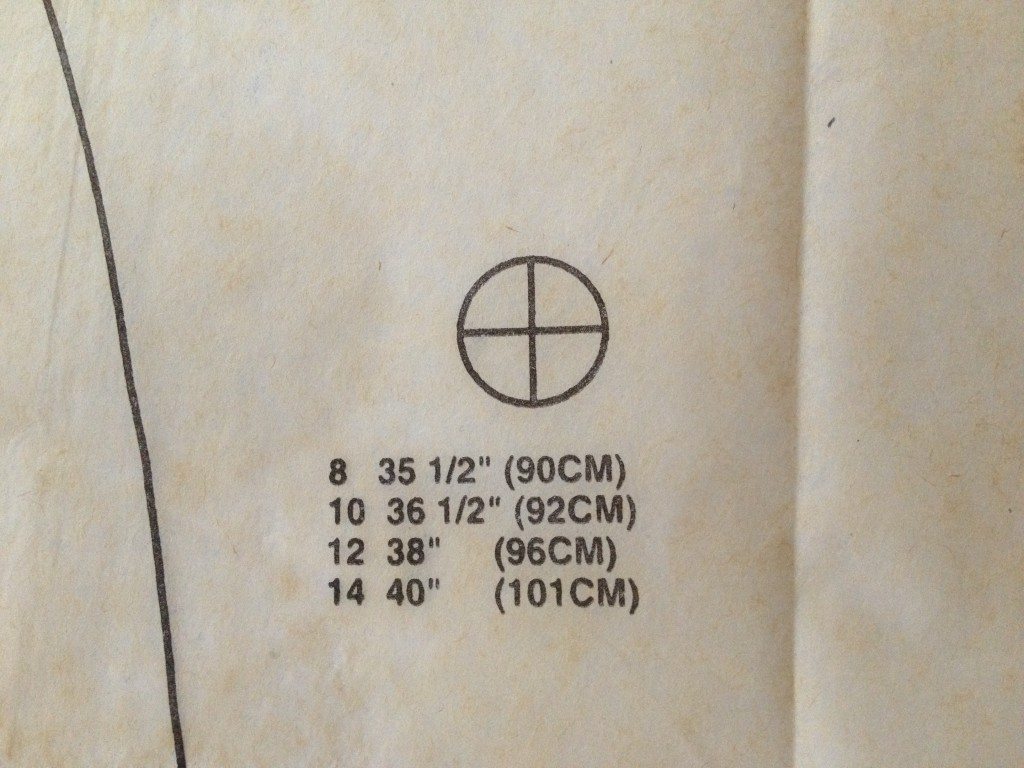
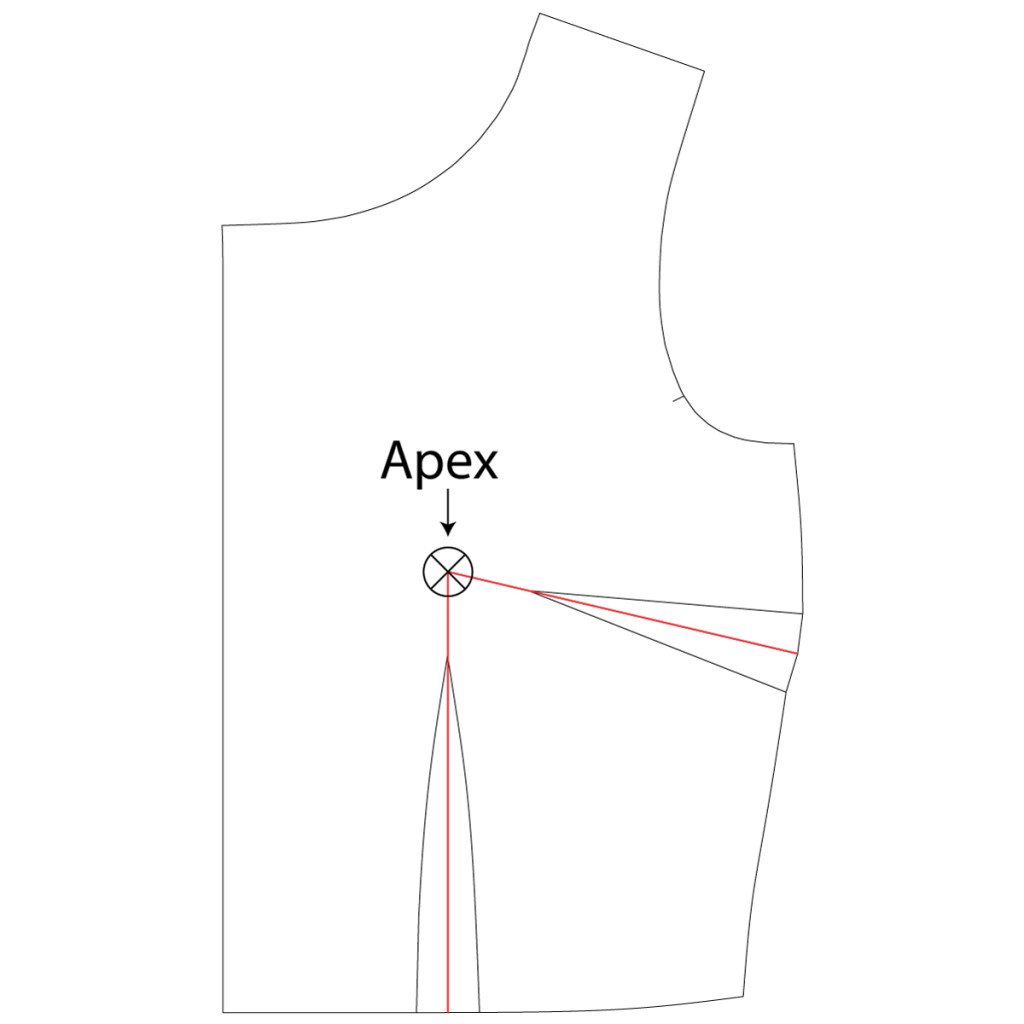
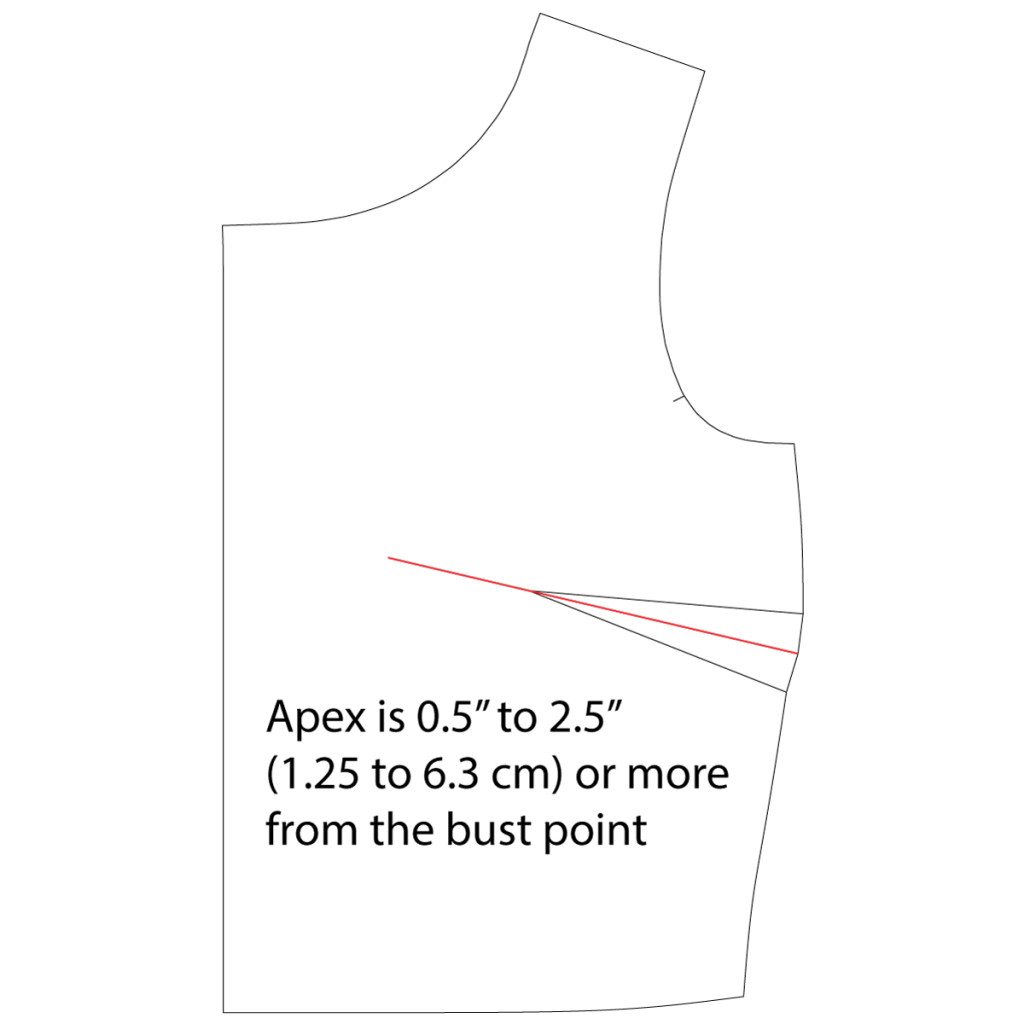
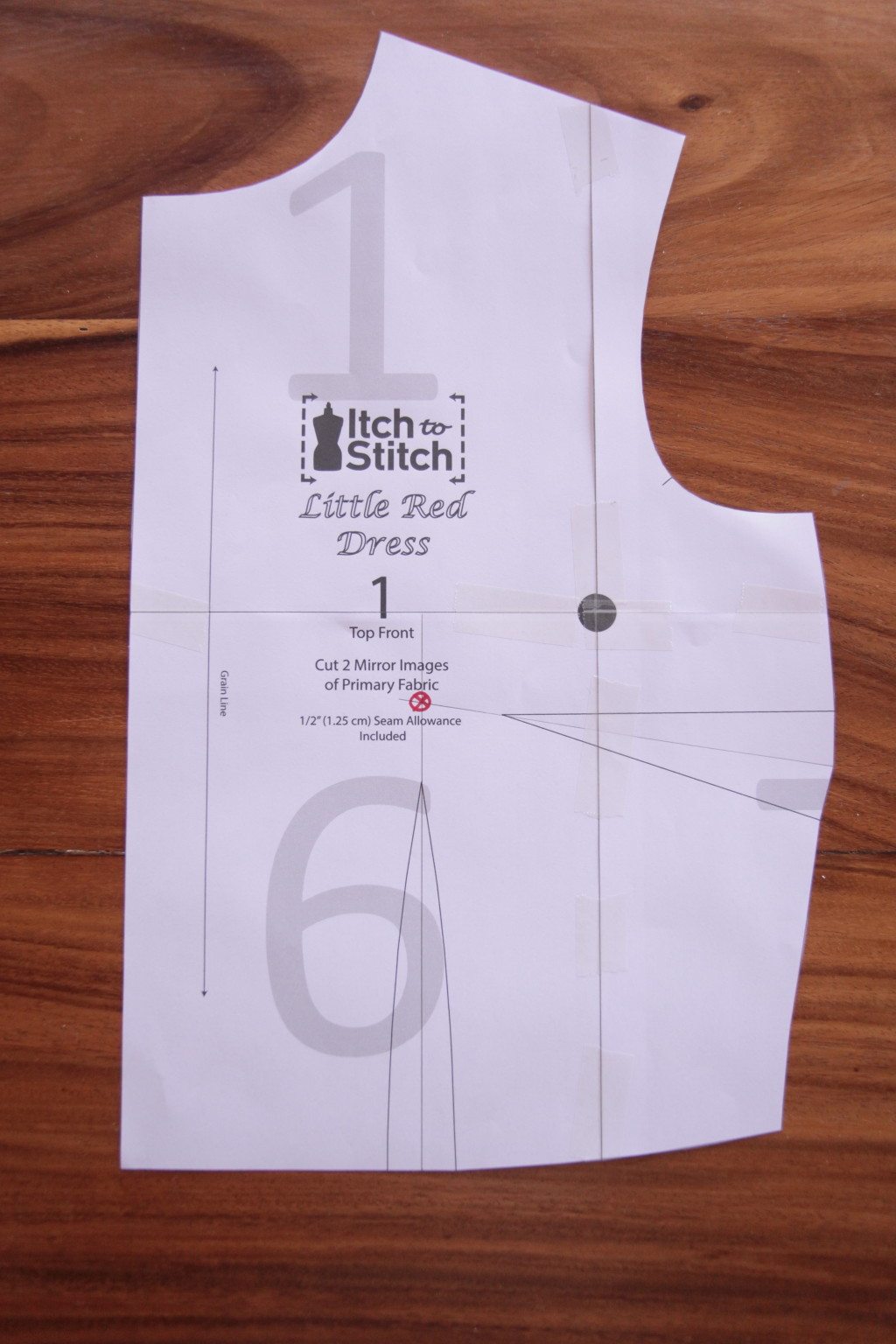
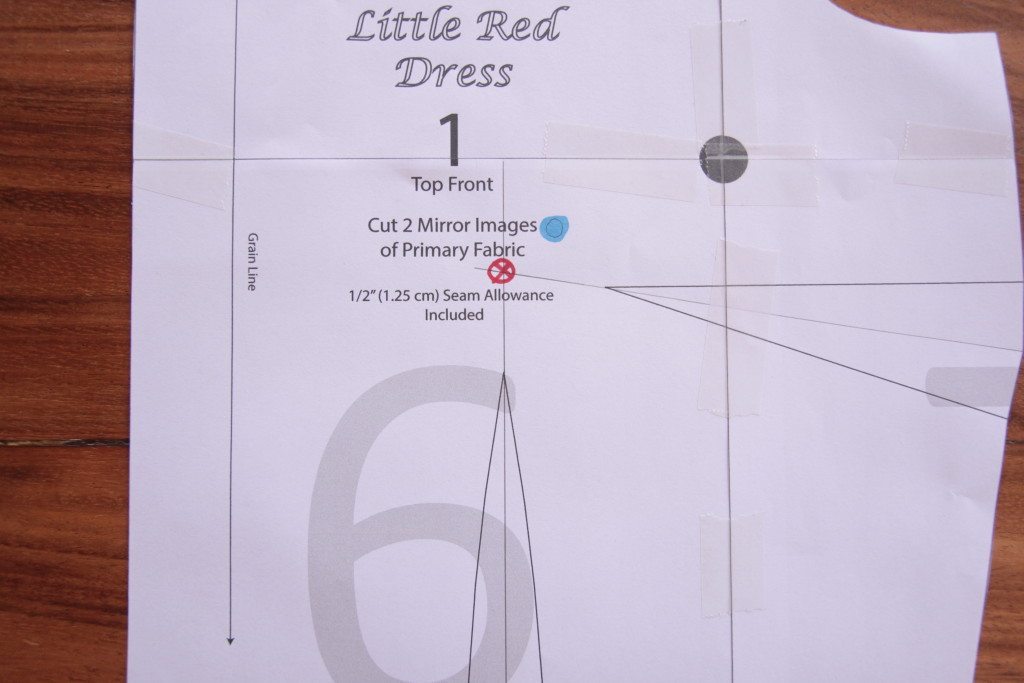
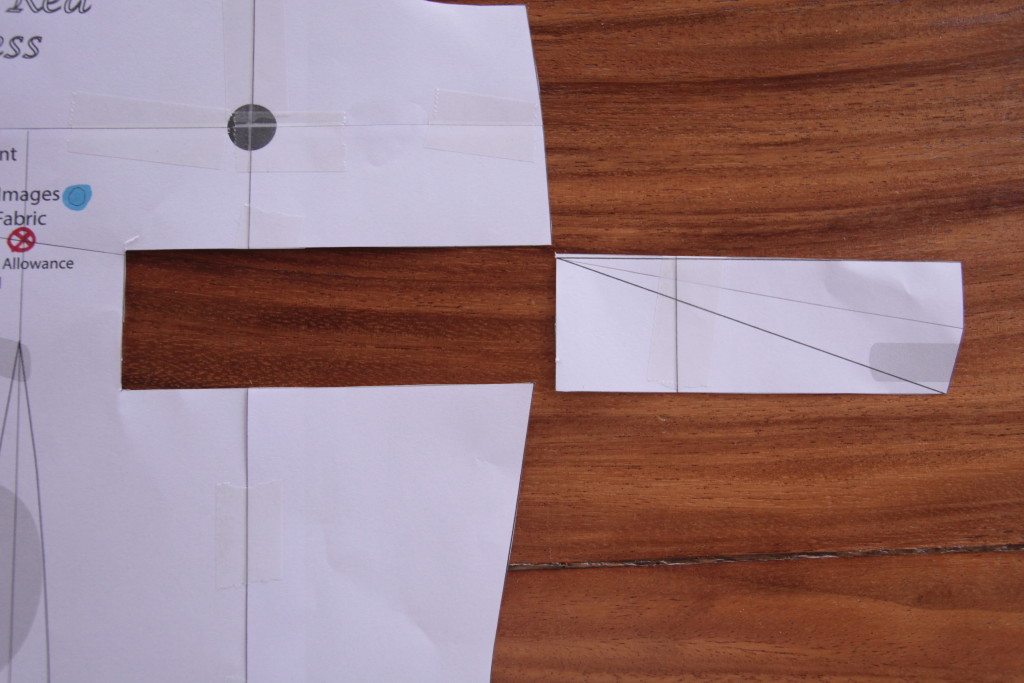
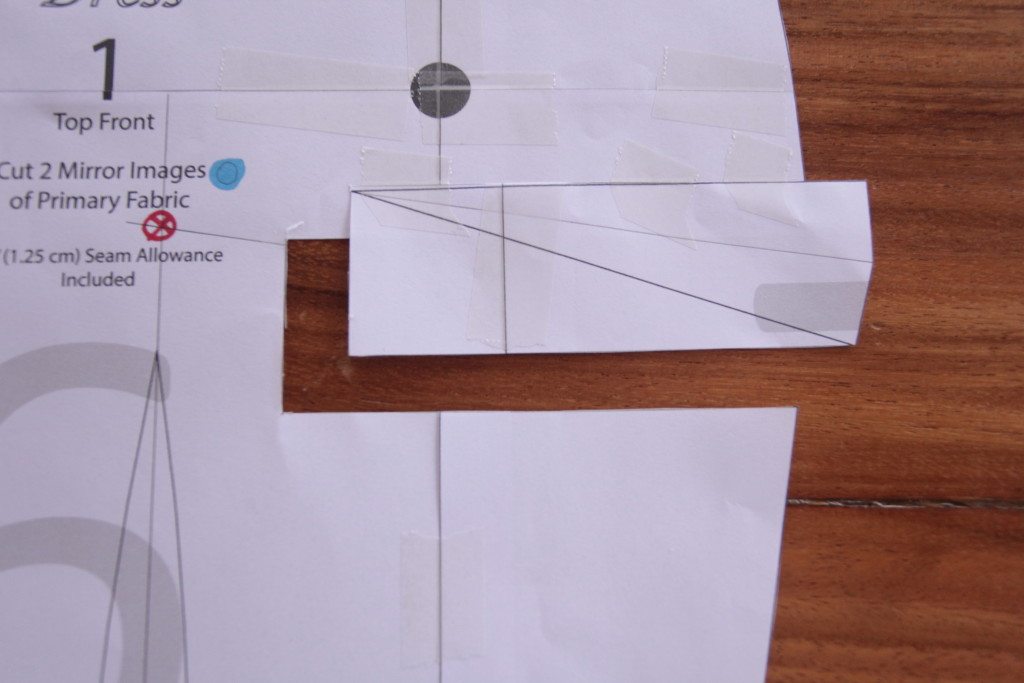
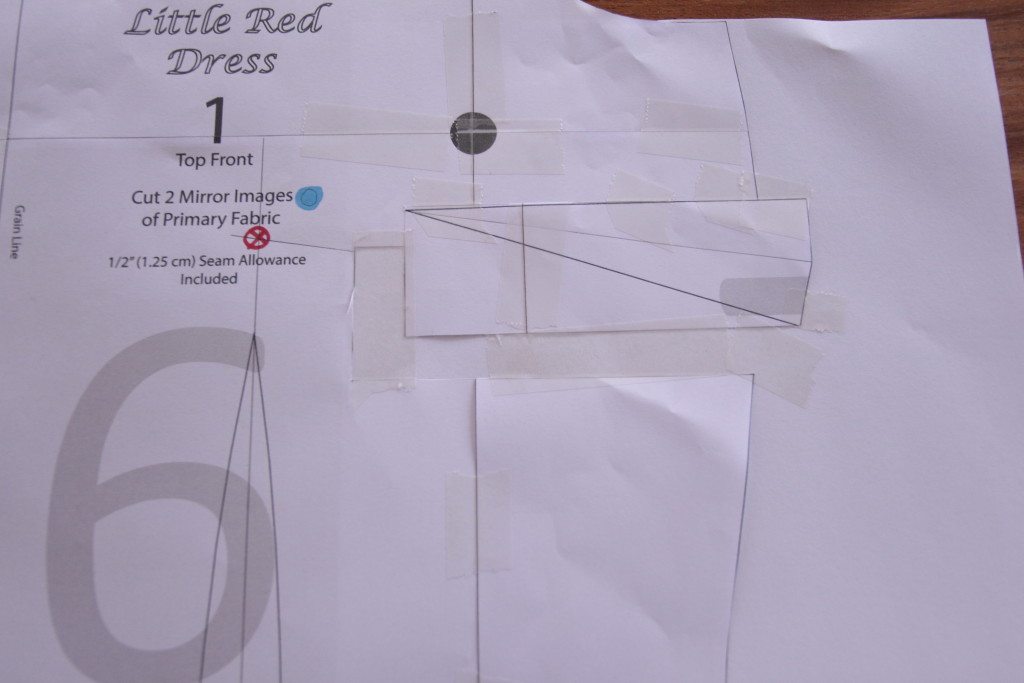
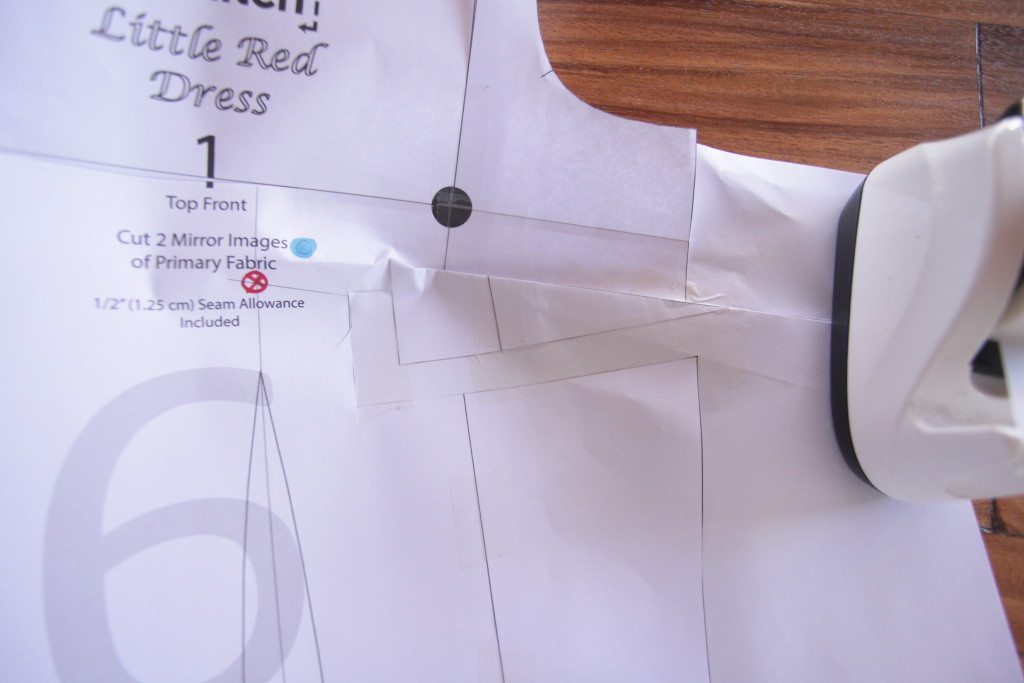
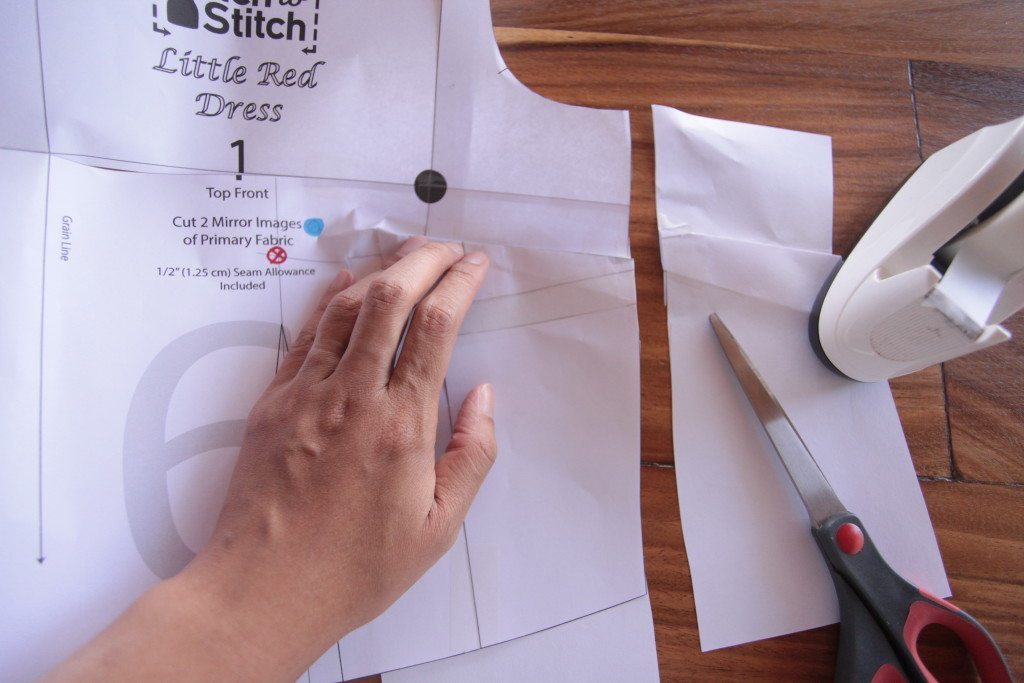
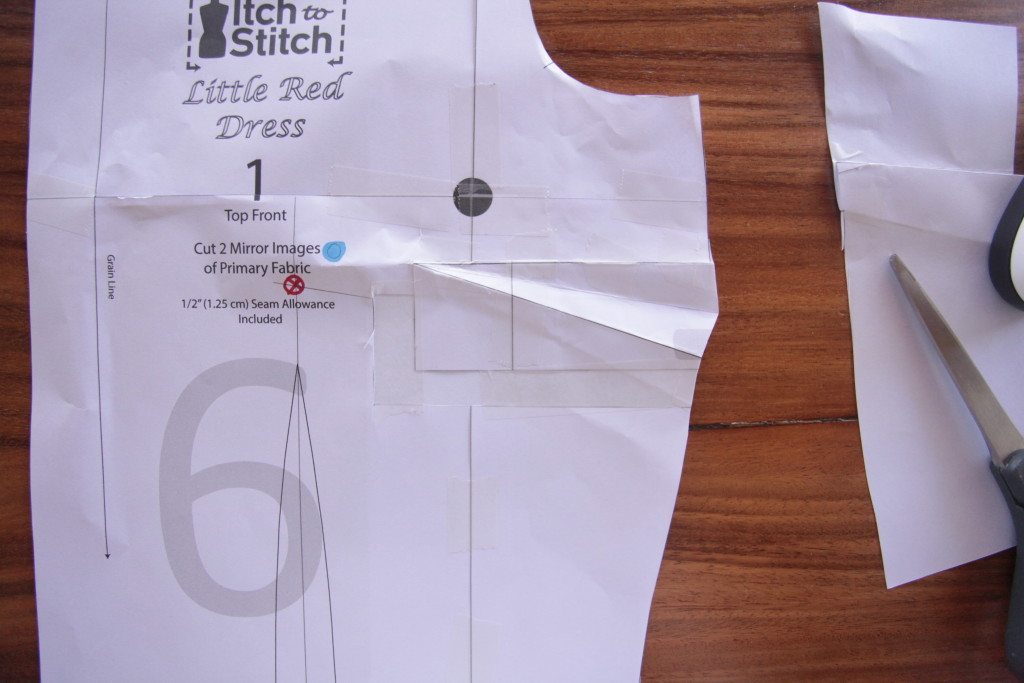
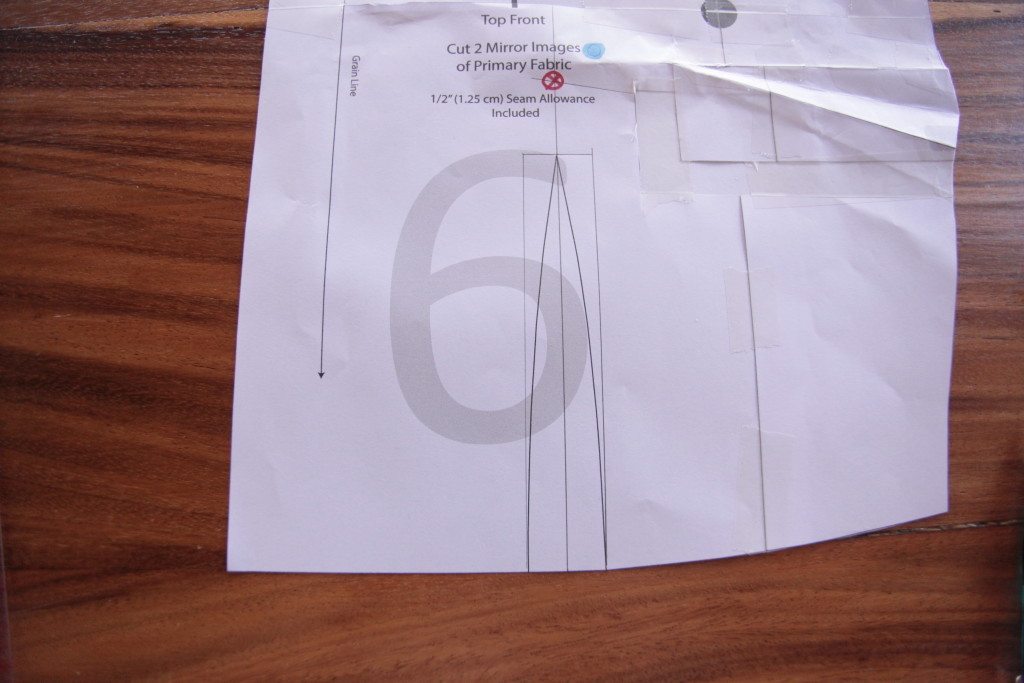
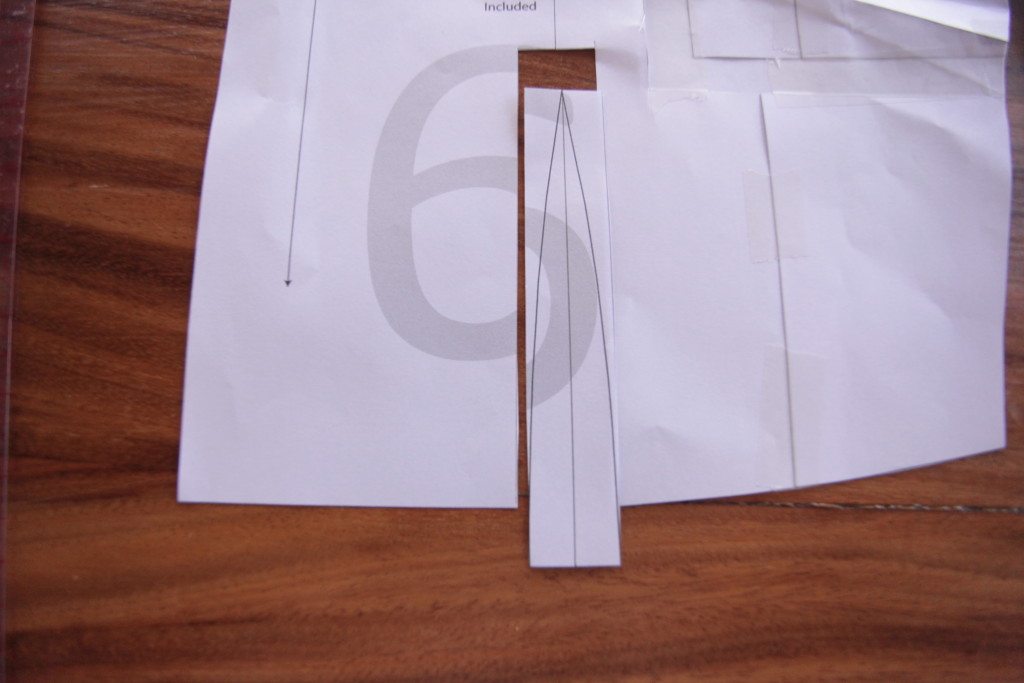

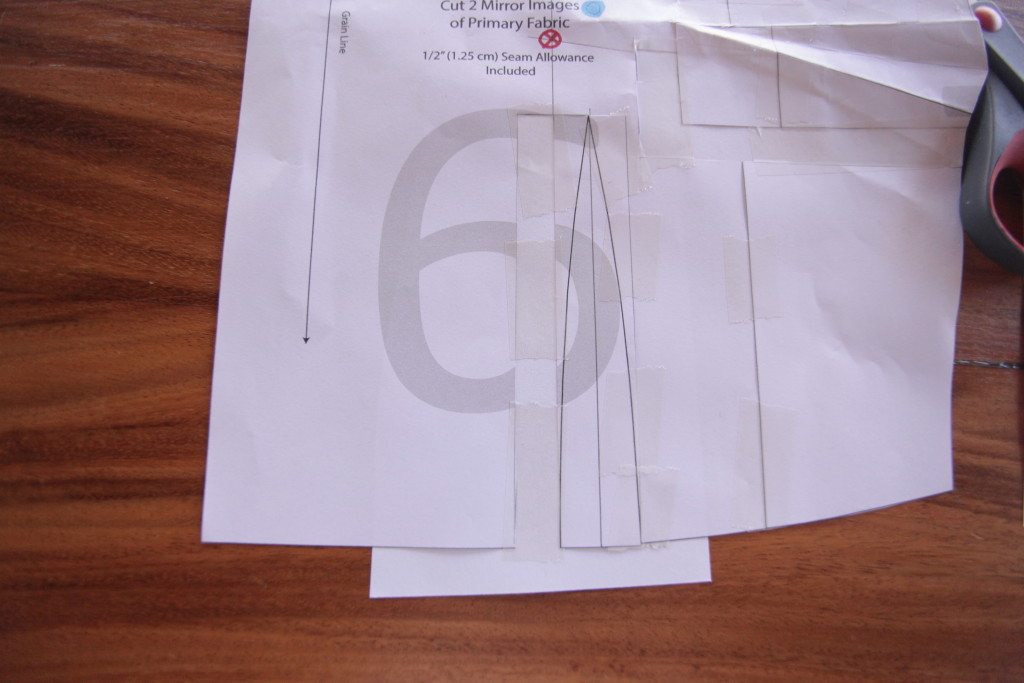


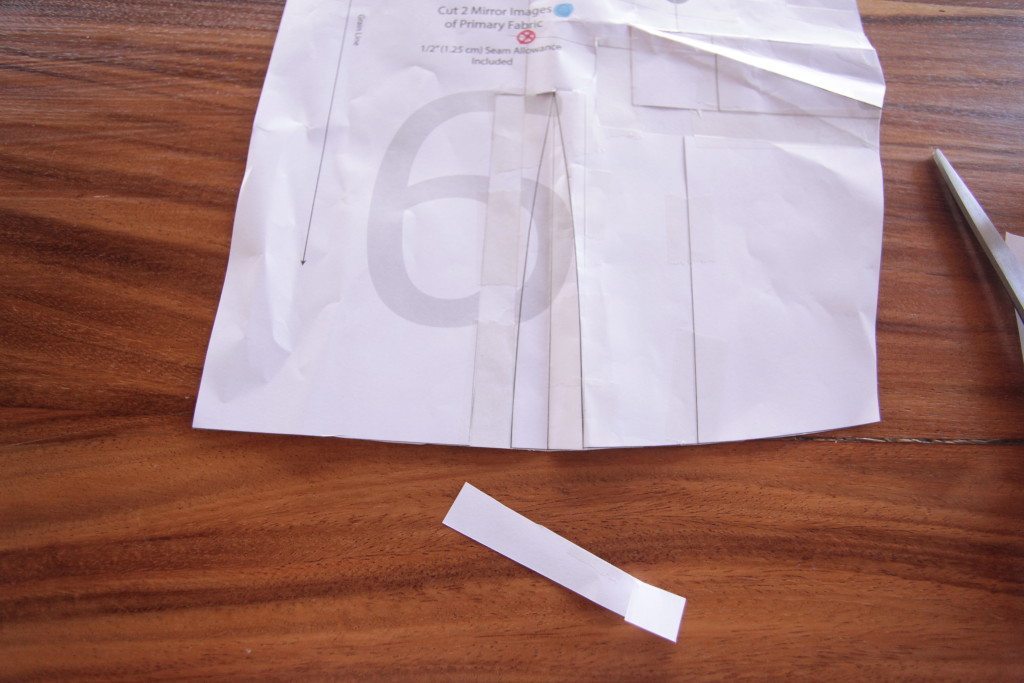

Hi Kennis – I’m about to make my first ITS pattern! When you move the bust dart horizontally (the 5/8 to the right) aren’t you slightly decreasing the dart uptake (width at side seam)? If so, would you true the front side seam to the back side seam lengthening the back, or shortening the front at the bottom? If you didn’t want to change the SS length, could you redraw the lower dart leg to the original uptake, or does that mess something up?
Hi Karen, it depends on what you need (what your figure is calling you to do), but generally speaking, the easiest would be to move the dart point outward 5/8″ and re-draw the dart to the original end points of the dart legs. That way the the uptake should be the same (it might be 1/32″ smaller if you are being very technically precise, but fabric is flexible; 1/32″ is well within the tolerance).
This may be a dumb question but here goes. I have a pattern with a bust and waist dart. I need to move the bust dart down about an inch and over 1/2 inch away from center front. Can I move both darts at the same time by cutting a large rectangle around the darts then moving? In may mind this should work but what’s in my mind doesn’t always work as I think it should. 🙂
Hi Sibyll, certainly it would work. There’s no particular sequence for you to move the darts.
This is so good and so helpful. It’s really helped me, thank you!
This is the best explanation I’ve seen! Thanks for the clear and concise pictures too. I was going crazy trying to adjust for FBA and broad middle.
Great tutorial! I have drafted my first bodice block. Once I have moved my apex and done a FBA, how far away from the apex should the dart points be? Thank you x
There’s no one answer. Anywhere between 1/2” to 2” is fair game. Basically, the rounder the cup, the farther away from the apex. You can sew a dart and then if it looks like there’s extra fabric, then you can unstitch it and re-sew with a dart point that is closer. Then you know what works for you for your future patterns too.
Thank you Kennis for getting back to me so soon. I ran out of time on this occasion to make my top. But I now know which areas to practise my skills. I am learning so much. x
I am interested in removing the dart altogether from my pattern — the jacket I made looks awesome on my husband except for the darn dart that is coming from the side. He’s almost exactly my size, except no bust 🙂
I would skip sewing the dart, smooth out the side seam, and remove the extra length at the bottom.
Now retired with adequate time to sew. With that said the body measurements have changed. With this tutorial I can modify/alter some blouse and other causal tops without having to buy new patterns. What other alteration tips do you post?
Thanks for this one!
Hi Joy, there’s a search box at the top left corner of the website. Whenever you think about an adjustment that you might need, you can try typing some keywords in there to find out.
I am using a Vogue pattern with only a wasit dart in the bodice. On the original pattern, the dart point does NOT point to the apex, but approximately 1/2 inch over, toward the arm side of the pattern., and about 1/2 inch below. So, the pattern apex is about 1/2 inch closer to the center front than my actual apex. This makes the dart point fall below my actual apex. So should I leave the dart placement, or should I move it, as the original pattern was drafted?
HI Marsha, different companies have different ways of doing things. I know some pattern makers back their darts horizontally like that. Just because I am used to my way of doing things, I think it’s more natural for the dart to point to the apex. The sure what to find our your preference is to make a muslin and baste your dart different ways to see which one is best for your figure. Different shapes might prefer one way or the other.
Helpful and easy explanation and steps to follow! Thank you for your resourceful info and your TIME taken to share your fitting procedures.
Thanks so much for this information! I sewed a muslin on a body, and saw that the darts were way too high (after two babies gravity did its work on my breasts….. also i guess my cupsize was a bit bigger than the pattern was intended for). With your tutorial i could just move the darts a bit lower, which resulted in a way better fit. Now i’m up for some more expensive fabric shopping and sewing a beautiful dress for my sisters wedding!!
Hi I’ve got a pattern where two double end darts sit side by side however when u trace down the line from the top of the dart at the tailor tack 14 it leads to a size 6 …. is it to make me take the widest edges of the dart and put them together?
Any ideas ?
Hi Polly, I think you are referring to fish eye dart? They are usually at the waist. But I don’t understand what you mean by “when u trace down the line from the top of the dart at the tailor tack 14 it leads to a size 6”. I will need to see some visual.
Mine, how to remove the darts entirely
Sorry, you can’t really remove the dart, because it’s there to shape your bust. However, you could manipulate it another location on the bodice. Google “bust dart manipulation”, and you will see lots of images and tutorials.
I don’t understand. You don’t clarify where to measure from. For instance. The bust needs to be moved on my garment 1 5/8 to right and 2 3/16 up. But I don’t know where the starting point is for me to measure 1 5/8 from. You never say. From the Apex? From where the dart originally was? The bottom or the top of the dart? I don’t know where to measure from.
Hi Vicki, from the apex.
This is a very helpful tutorial!! I am currently in a bit of a bind on a project I’m working on. The pattern is a relaxed shirtdress type. When I made my muslin, I originally had pockets placed over the front. The pockets covered most of the bust darts, so I didn’t really notice a problem. Now that I am using my fashion fabric, I decided that the type of fabric I am using would be better suited to a no pocket look. Guess what… those bust darts now appear approximately 3/4 too low (and of course they’re the neatest darts I’ve ever sewn ?). Is it possible to move the darts up this late in the game or would I just end up making the whole garment look off? Any advice would be very much appreciated!
Hi Jen, 3/4″ is not a whole lot. What I’d do is to undo the dart, and then move the dart point up 3/4″ (with the end of the dart legs at the side seam remain the same). The dart bulk will be completely trued as a result, but it should still work (since you are not moving a lot). Also, be sure you are wearing the bra that you want to wear before you decide to change the dart, because it does make a different how high your apex will be. Good luck!
Oops, that was supposed to say 1 3/4″… still the same fix?
Yes, I would.
THANK YOU!! This tutorial was fantastic, and I just moved my first bust darts. The result was perfect. I’m thrilled–thanks again!! 🙂
I am glad you found it useful Michelle ?
Wondering your recommendation for the distance from the Apex to the dart point on the Anza bodice (I’m trying it out!)
Thanks!
Hi Melanie, there’s really no straight-up answer to your question. For a smaller cup, the distance could be 1/2″, but for a larger cup, the distance could be 2″. And if the cup is more “pointy”, then the distant could be shorter, while a fuller, rounder cup would be farther away. Sorry this is probably not an answer you are hoping for. The good news is that you could try it out, and if your bust is not filling the available space, you could always try again and stitch closer.
Thank for this! The instructions were very clear and helpful.
This was so helpful and effective! Thank you!
This was very informative. I have steered away from women’s patterns the included darts for fear of not being able to get a good fit. I’ll be saving this information for my sewing toolbox!
Practice makes perfect! (And we don’t even need to be perfect! 🙂 )
It can definitely get tricky to fold up a dart in paper, especially when you have layers of tape and pieced together paper. I use a tracing method to true up darts so I don’t have to fold the paper: http://growyourownclothes.com/2015/09/26/a-little-tip-for-trueing-up-darts/
Tracing is a good way to do it, especially on thinner paper. I have a big roll of medical paper. It’s thin, strong and relatively inexpensive.
What is medical paper and where can it be purchased?
Thanks for such a clear tutorial. I’ve seen pictures of cutting the patterns but not how to put them back together again.
Medical paper is the stuff they use over exam tables. It works pretty well as tracing paper. I got mine on Amazon: http://www.amazon.com/dp/B0037INEGE/
Cassy, medical paper is the type that clinics/hospitals lay on their examination beds. You can buy it on Amazon: http://amzn.to/1MMLVSd. It’s translucent so you can see through, which is quite handy for tracing. And it’s reasonably strong, even stronger than the tissue paper used by the Big 4 for printed patterns. And it’s cheap; you get a huge roll for very little.
Great tutorial. Always wondered how to do this
I am so glad to see a tute in which the importance of finding the bustpoint is indicated . FOr me , with my In very sence different body ! It is very very important to find that on the pattern. THe same for a waist and a shoulderline. IN adapting patterns it is very helpful to find those indications on the pattern even if for average bodies it seems not so relevant to have those reference points